Bore Cleaning Basics
By Matthew Cameron
The carbon and copper left in a rifle bore after firing a single or multiple shots needs to be dealt with if the accuracy potential of the bore is to be maintained.
Rifles owned by target and benchrest shooters are cleaned frequently to maintain their competitive edge; dirty barrels simply do not shoot to the required level of performance. The cleaning practices and equipment of these shooters is a starting point on how to clean other rifles. There are good reasons for the use of specific items in the cleaning process. Some of the gear might be considered expensive. However, cleaning equipment is much cheaper than a new barrel.
When you mention barrel cleaning a lot of shooters get a bit coy as to exactly how they carry out the process. A basic pull through might be sufficient for a .22 rim fire but is hardly adequate for a centre fire of any calibre. What we need to do is to eliminate all of the carbon and copper that is left in the bore, there are many different ways to attack the problem. Whilst you may be able to eliminate all of the copper, I am not totally convinced that it is possible to totally remove all carbon after the rifle has had some use.
If we fail to clean a bore in a proper manner from its initial pristine condition it may cause problems later on. A friend's 22/250 Remington had a dark ring of carbon at the beginning of the lands. It was very difficult to remove. He admitted that he had not thought much about the initial cleaning and had not used any particular system. Accuracy had deteriorated over time.
If a bore is badly fouled it may take several weeks to remove the accumulated copper and carbon. It happened to another acquaintance of mine who purchased a used rifle. Externally in mint condition, the bore was another situation entirely. It took many different fluids and cleaning techniques to remove the accumulation.
As a starting point, you need some sort of cleaning cradle to hold the rifle. If you are unsure ask your shooting friends and the local gun shop. There are several commercial types available. Nothing is more impossible than trying to hold a rifle in one hand and a cleaning rod in the other.
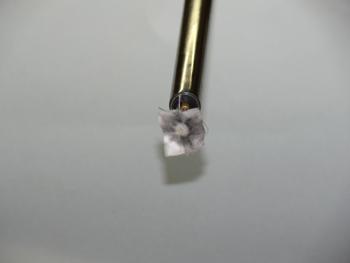
Residue from a singular primer.
Next, we need a bore guide, considered by some to be useless and an added expense that is not justified. It does a couple of things that are important. Firstly it keeps excessive solvents from leaking into the trigger and bedding; these fluids will attack most bedding and effectively turn it into pulp--useless!
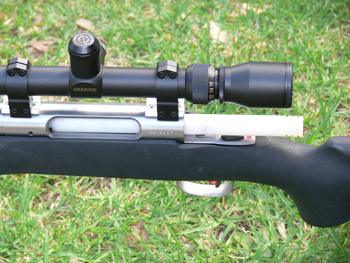
Correct size bore guides are necessary.
Further it will align the cleaning rod with the bore. The best types have an O ring seal and are calibre specific. Pay the price and protect your investment. There is another type that is not calibre specific and lacks the sealing O ring. It is better than none at all. With this type is may be necessary to swab the cartridge chamber after cleaning to eliminate any drips.
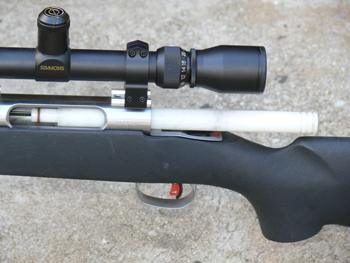
Custom bore guide. Note red sealing O ring.
Cleaning rods are the proverbial bone of contention. Everyone has an opinion. You will have to do some research and make up your own mind. Rods are available in one piece, two pieces; and some even more. Target shooters are usually very specific in their requirements; their choice will be a one piece rod with a rotating handle. It is suggested that this is the best type.
The next decision is whether the rod should be plastic coated or bare metal; each type has its followers. The target group favors the coated type. Irrespective of what you choose you MUST keep it clean by wiping with a paper towel or a cleaning cloth after each trip down the bore. This is particularly important with plastic coated rods; you do not want to contaminate the rod with dirt or grime of any sort.
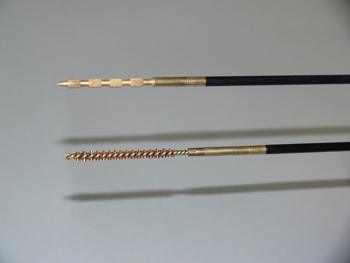
Correct size jags and brushes are important.
To insert cleaning fluids into a bore, there are two distinct schools of thought. One group suggests that scrubbing with a bore brush loaded with the appropriate fluid is necessary; the other claims that the correct fluid alone is enough and scrubbing is unnecessary. The fluid only people use bristle brushes or wool mops, and some use patches, whilst the scrubbing group use high quality bronze brushes. These bronze brushes are calibre specific. They are the next item to consider on the cleaning agenda. Make sure that the brushes you use fit the rod. There are several types available, and they are not always thread compatible.
A personal preference is the use of bronze brushes; loaded with the appropriate solution it achieves two purposes. It scrubs the embedded carbon and also etches the copper layer allowing the copper removing solvent to work more effectively. If you are going to use brushes, have the correct size for each calibre that you own. Worn brushes defeat the initial purposes for which they are used. If you insert the brush in the bore and it can be withdrawn, it is past its useful life and should be disposed of.
Other than the correct size for each caliber, it is important to keep brushes clean. Do not leave them to roll around the bottom of your cleaning box. Cheap plastic containers are ideal for storage. Use a separate container for each calibre.
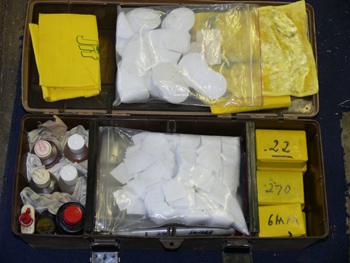
All cleaning gear is stored in a singular box.
Cleaning jags are also calibre specific and are used to insert patches into the bore; there are multiple types available, of which I will mention two.
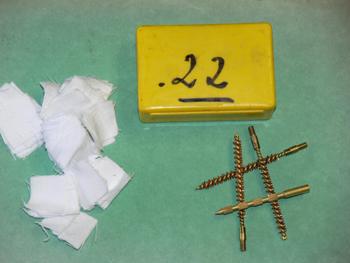
Patches, brushes and jags have to be the correct size.
The Parker Hale type uses a wrap around patch whilst the Dewey style allows multiple choices. You may pierce the patch through the centre or wrap it around similar to the Parker Hale type. The Dewey type is a bit more flexible, however it is a matter of personal opinion. Like the brushes, keep the jags clean and store them in the same brush container.
Perhaps the most important item in the whole cleaning process is the cleaning patch. Similar to the brushes and jags, there is a correct size for each calibre. The patch may be used with fluid as an initial swab through the bore. Thereafter, a series of patches will be used to remove the fluid and accumulated waste. It is important that the patch be of the correct size. If not, it may be either too loose or too tight. Neither situation is acceptable for efficient cleaning.
Once again, there are multiple choices, but it appears that cotton cloth is the most widely used, purchase in bulk so that you always have an adequate supply. The one inviolate rule with patches is that a dirty patch should NEVER be pulled back into the bore. Once again, patches, like brushes, are cheap.
There are a multitude of bore cleaning fluids available and there appear to be more on the market each year. If you are not sure what to use, ask your friends which are their preferred fluids, and more importantly why do they use them.
Although solvent makers suggest that their particular fluid will remove both copper and carbon, perhaps a faster method is to use different fluids to achieve the desired result, particularly if time is a consideration. Some fluids, especially those designed to remove copper, require a considerable amount of time to be effective.
The author does not claim to have used all of the cleaning fluids available or even a large percentage of them: I have yet to use any single solvent that will remove both carbon and copper in a short time period.
If we fire either a single, or more likely multiple shots, the last item left in the barrel is the primer and powder residue from the last shot. I suggest that we need to eliminate as much as possible of this carbon first. Underneath this top layer there will be several other layers of carbon intermixed with a layer or layers of copper from the exiting bullet(s).
Other than the specific bore cleaning fluids, there are others that I suggest have an application in the bore cleaning process, even though designed for other uses. There are two automotive fluids that are suitable to attack carbon. Brake Clean is used to remove carbon from automotive brake systems. In a similar manner, carburetor cleaner is used to externally clean around carburetors.
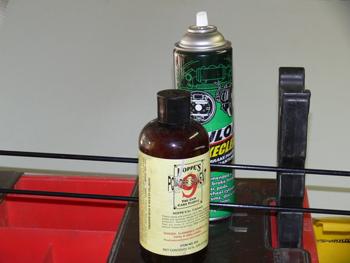
Hoppes #9 and Brake Clean are author's preferred solvents.
My personal bore cleaning process starts with two pierced patches run through the bore after spraying with Brake Clean, both patches are pushed through the bore and allowed to fall off when the rod is withdrawn.
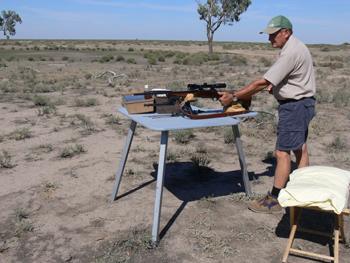
Bore cleaning is not always carried out in pristine conditions!
The same applies to at least two dry patches that follow; this will remove some of the carbon. You could achieve the same result using Hoppes #9. The choice is personal. If the second dry patch contains evidence of black, use at least another two.
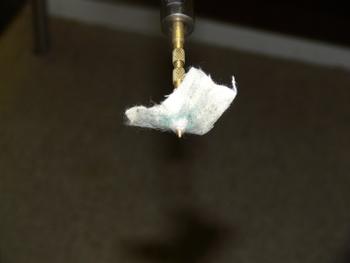
First patch through the bore with Brake Clean.
The correct size bore brush is now loaded with Hoppes #9, and the bore stroked several times to dislodge further carbon. Remember to clean the rod after each application through the bore. To clean the bore brush, hold it vertical and spray with Brake Clean. If time is not a consideration, leave the brushed barrel sit for about ten minutes and then patch dry. It may take up to four or five patches. Whilst the above two processes should have dislodged most of the carbon, there are now two further distinct processes to attack the copper.
Hoppes #9 is an effective copper remover that has two limitations. The first is that it requires oxygen. The second is time. If you wish to use Hoppes #9 to remove copper, saturate a clean patch and push it slowly through the bore.
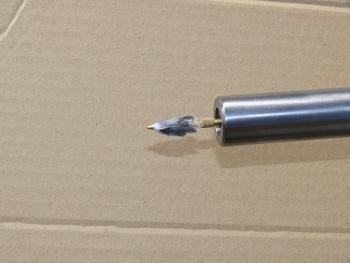
Green on the cleaning patch indicates there is still copper in the bore (Hoppes #9)
Allow it to sit for at least twenty four hours and patch it dry. Repeat as necessary until the patches come out clean without any green streaks. It is a very slow process. If you are in a competition, time is of importance and you cannot wait for #9 to work.
The other option is to use an aggressive ammonia based fluid such as Sweets 7.62 solvent that will remove copper quickly. It is a very strong solution. A patch saturated with Sweets is wrapped around either type of previously mentioned jags, and the bore stroked several times. The patch will come out blue, indicating the presence of copper. Allow the barrel to sit in a saturated state for about ten minutes and patch dry. If there is a lot of copper present it may be necessary to repeat the process. Other than a patch, you could use a cotton bore mop to apply the Sweets.
As an absolute maximum, Sweets should NOT be left in a bore more than FIFTEEN minutes. This warning appears on the Sweets bottle. This time frame applies to ANY ammonia based product. By now the bore should be squeaky clean.
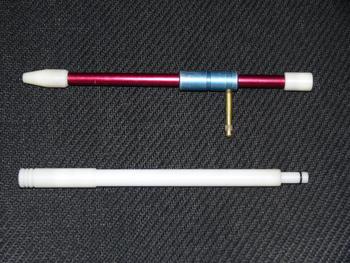
Multiple calibre rod guide (top). Calibre specific (below).
How often do you clean? Perhaps of more importance, how often should you clean?
This is not easy to answer and you have to consider the cartridge type and frequency of use. An over bore high intensity varmint cartridge should probably be cleaned after ten or so shots, a "normal" hunting rifle perhaps after fifteen or twenty, a benchrest rifle after each relay. You will note that we are talking about non coated bullets; moly coated projectiles are another type entirely with totally different cleaning requirements.
Whatever the cleaning regime, having removed the offending carbon and copper, there is still a requirement to protect the bore between shooting trips. Should we apply further liquid(s) to protect the bore in storage? A personal preference is a 50/50 mixture of Hoppes #9 and Penetrene. Both will prevent any chance of rust and the Hoppes will work on any residual copper, if any. Before the rifle is next fired, a couple of dry patches will eliminate the mixture out of the bore.
Bore cleaning can be a long process with several rifles to clean after a day in the field. Usually it assists the cleaning process to run a patch saturated with Hoppes #9 through the bore at the end of the day's shooting. The trip home allows time for the Hoppes to work.
You might be surprised at the amount of green on the first dry patch through the barrel.
There is a lot of misinformation about cleaning. The above is basic information that needs fine tuning depending on individual rifles, barrel steel types and the amount of use. Everyone has an opinion, and you have to make up your own mind.
Stainless barrels do not appear to foul as much as conventional steels. Older steel types may require more attention. Some barrels will show evidence of copper, some will not. One rifle in the author's gun safe, calibre .243Winchester, only shows black in the bore after use. Sweets confirms that the copper is present. The load is on the mild side using commercial projectiles. Another rifle, different steel, shows copper near the muzzle after two or three shots.
There is one inviolate rule that must be applied to bore cleaning. Irrespective of the cleaning fluids you choose to use, they should NEVER be mixed. Use a particular fluid and patch it dry before using the next.
A current suggestion is not to pull a wet bore brush back into the barrel, the claim is that the bronze bristles will inflict minute damage to the barrel crown and hence destroy accuracy. As matter of interest I looked at two custom stainless barrels with a high powered magnifying glass. No such damage was evident.
A word of warning about the fluids that are used in the cleaning process. Many are of a volatile nature, and if inhaled in sufficient quantities could be harmful. To avoid this situation you should always clean your firearms in a well ventilated area. Some shooters have taken the process one step further and wear cheap disposable gloves when cleaning.
Another consideration is to prevent all solvents dripping onto any part of the stock, particularly those that are wood with a finishing top coat. Some solvents will immediately attack such finishes and leave you with a damaged stock. Protecting the stock with a small towel during cleaning is one solution to this problem.
With the cost of quality firearms rising continually, good cleaning practices are important. Like everything else in shooting, you pay for good quality products. Look upon cleaning gear as an investment, it will always return good results.
Matthew Cameron is a retired Australian Airline Pilot who flew domestically within Australia and internationally out of Southeast Asia. Interested in long range varminting and pig shooting for many years, he reloads for a variety of calibres and has written articles on reloading and associated subjects since the early 1990's, published in Australia, South Africa and New Zealand. In the last few years he has enjoyed bench rest shooting and gliding when not reloading or writing.

By Matthew Cameron
The carbon and copper left in a rifle bore after firing a single or multiple shots needs to be dealt with if the accuracy potential of the bore is to be maintained.
Rifles owned by target and benchrest shooters are cleaned frequently to maintain their competitive edge; dirty barrels simply do not shoot to the required level of performance. The cleaning practices and equipment of these shooters is a starting point on how to clean other rifles. There are good reasons for the use of specific items in the cleaning process. Some of the gear might be considered expensive. However, cleaning equipment is much cheaper than a new barrel.
When you mention barrel cleaning a lot of shooters get a bit coy as to exactly how they carry out the process. A basic pull through might be sufficient for a .22 rim fire but is hardly adequate for a centre fire of any calibre. What we need to do is to eliminate all of the carbon and copper that is left in the bore, there are many different ways to attack the problem. Whilst you may be able to eliminate all of the copper, I am not totally convinced that it is possible to totally remove all carbon after the rifle has had some use.
If we fail to clean a bore in a proper manner from its initial pristine condition it may cause problems later on. A friend's 22/250 Remington had a dark ring of carbon at the beginning of the lands. It was very difficult to remove. He admitted that he had not thought much about the initial cleaning and had not used any particular system. Accuracy had deteriorated over time.
If a bore is badly fouled it may take several weeks to remove the accumulated copper and carbon. It happened to another acquaintance of mine who purchased a used rifle. Externally in mint condition, the bore was another situation entirely. It took many different fluids and cleaning techniques to remove the accumulation.
As a starting point, you need some sort of cleaning cradle to hold the rifle. If you are unsure ask your shooting friends and the local gun shop. There are several commercial types available. Nothing is more impossible than trying to hold a rifle in one hand and a cleaning rod in the other.

Residue from a singular primer.
Next, we need a bore guide, considered by some to be useless and an added expense that is not justified. It does a couple of things that are important. Firstly it keeps excessive solvents from leaking into the trigger and bedding; these fluids will attack most bedding and effectively turn it into pulp--useless!

Correct size bore guides are necessary.
Further it will align the cleaning rod with the bore. The best types have an O ring seal and are calibre specific. Pay the price and protect your investment. There is another type that is not calibre specific and lacks the sealing O ring. It is better than none at all. With this type is may be necessary to swab the cartridge chamber after cleaning to eliminate any drips.

Custom bore guide. Note red sealing O ring.
Cleaning rods are the proverbial bone of contention. Everyone has an opinion. You will have to do some research and make up your own mind. Rods are available in one piece, two pieces; and some even more. Target shooters are usually very specific in their requirements; their choice will be a one piece rod with a rotating handle. It is suggested that this is the best type.
The next decision is whether the rod should be plastic coated or bare metal; each type has its followers. The target group favors the coated type. Irrespective of what you choose you MUST keep it clean by wiping with a paper towel or a cleaning cloth after each trip down the bore. This is particularly important with plastic coated rods; you do not want to contaminate the rod with dirt or grime of any sort.

Correct size jags and brushes are important.
To insert cleaning fluids into a bore, there are two distinct schools of thought. One group suggests that scrubbing with a bore brush loaded with the appropriate fluid is necessary; the other claims that the correct fluid alone is enough and scrubbing is unnecessary. The fluid only people use bristle brushes or wool mops, and some use patches, whilst the scrubbing group use high quality bronze brushes. These bronze brushes are calibre specific. They are the next item to consider on the cleaning agenda. Make sure that the brushes you use fit the rod. There are several types available, and they are not always thread compatible.
A personal preference is the use of bronze brushes; loaded with the appropriate solution it achieves two purposes. It scrubs the embedded carbon and also etches the copper layer allowing the copper removing solvent to work more effectively. If you are going to use brushes, have the correct size for each calibre that you own. Worn brushes defeat the initial purposes for which they are used. If you insert the brush in the bore and it can be withdrawn, it is past its useful life and should be disposed of.
Other than the correct size for each caliber, it is important to keep brushes clean. Do not leave them to roll around the bottom of your cleaning box. Cheap plastic containers are ideal for storage. Use a separate container for each calibre.

All cleaning gear is stored in a singular box.
Cleaning jags are also calibre specific and are used to insert patches into the bore; there are multiple types available, of which I will mention two.

Patches, brushes and jags have to be the correct size.
The Parker Hale type uses a wrap around patch whilst the Dewey style allows multiple choices. You may pierce the patch through the centre or wrap it around similar to the Parker Hale type. The Dewey type is a bit more flexible, however it is a matter of personal opinion. Like the brushes, keep the jags clean and store them in the same brush container.
Perhaps the most important item in the whole cleaning process is the cleaning patch. Similar to the brushes and jags, there is a correct size for each calibre. The patch may be used with fluid as an initial swab through the bore. Thereafter, a series of patches will be used to remove the fluid and accumulated waste. It is important that the patch be of the correct size. If not, it may be either too loose or too tight. Neither situation is acceptable for efficient cleaning.
Once again, there are multiple choices, but it appears that cotton cloth is the most widely used, purchase in bulk so that you always have an adequate supply. The one inviolate rule with patches is that a dirty patch should NEVER be pulled back into the bore. Once again, patches, like brushes, are cheap.
There are a multitude of bore cleaning fluids available and there appear to be more on the market each year. If you are not sure what to use, ask your friends which are their preferred fluids, and more importantly why do they use them.
Although solvent makers suggest that their particular fluid will remove both copper and carbon, perhaps a faster method is to use different fluids to achieve the desired result, particularly if time is a consideration. Some fluids, especially those designed to remove copper, require a considerable amount of time to be effective.
The author does not claim to have used all of the cleaning fluids available or even a large percentage of them: I have yet to use any single solvent that will remove both carbon and copper in a short time period.
If we fire either a single, or more likely multiple shots, the last item left in the barrel is the primer and powder residue from the last shot. I suggest that we need to eliminate as much as possible of this carbon first. Underneath this top layer there will be several other layers of carbon intermixed with a layer or layers of copper from the exiting bullet(s).
Other than the specific bore cleaning fluids, there are others that I suggest have an application in the bore cleaning process, even though designed for other uses. There are two automotive fluids that are suitable to attack carbon. Brake Clean is used to remove carbon from automotive brake systems. In a similar manner, carburetor cleaner is used to externally clean around carburetors.

Hoppes #9 and Brake Clean are author's preferred solvents.
My personal bore cleaning process starts with two pierced patches run through the bore after spraying with Brake Clean, both patches are pushed through the bore and allowed to fall off when the rod is withdrawn.

Bore cleaning is not always carried out in pristine conditions!
The same applies to at least two dry patches that follow; this will remove some of the carbon. You could achieve the same result using Hoppes #9. The choice is personal. If the second dry patch contains evidence of black, use at least another two.

First patch through the bore with Brake Clean.
The correct size bore brush is now loaded with Hoppes #9, and the bore stroked several times to dislodge further carbon. Remember to clean the rod after each application through the bore. To clean the bore brush, hold it vertical and spray with Brake Clean. If time is not a consideration, leave the brushed barrel sit for about ten minutes and then patch dry. It may take up to four or five patches. Whilst the above two processes should have dislodged most of the carbon, there are now two further distinct processes to attack the copper.
Hoppes #9 is an effective copper remover that has two limitations. The first is that it requires oxygen. The second is time. If you wish to use Hoppes #9 to remove copper, saturate a clean patch and push it slowly through the bore.

Green on the cleaning patch indicates there is still copper in the bore (Hoppes #9)
Allow it to sit for at least twenty four hours and patch it dry. Repeat as necessary until the patches come out clean without any green streaks. It is a very slow process. If you are in a competition, time is of importance and you cannot wait for #9 to work.
The other option is to use an aggressive ammonia based fluid such as Sweets 7.62 solvent that will remove copper quickly. It is a very strong solution. A patch saturated with Sweets is wrapped around either type of previously mentioned jags, and the bore stroked several times. The patch will come out blue, indicating the presence of copper. Allow the barrel to sit in a saturated state for about ten minutes and patch dry. If there is a lot of copper present it may be necessary to repeat the process. Other than a patch, you could use a cotton bore mop to apply the Sweets.
As an absolute maximum, Sweets should NOT be left in a bore more than FIFTEEN minutes. This warning appears on the Sweets bottle. This time frame applies to ANY ammonia based product. By now the bore should be squeaky clean.

Multiple calibre rod guide (top). Calibre specific (below).
How often do you clean? Perhaps of more importance, how often should you clean?
This is not easy to answer and you have to consider the cartridge type and frequency of use. An over bore high intensity varmint cartridge should probably be cleaned after ten or so shots, a "normal" hunting rifle perhaps after fifteen or twenty, a benchrest rifle after each relay. You will note that we are talking about non coated bullets; moly coated projectiles are another type entirely with totally different cleaning requirements.
Whatever the cleaning regime, having removed the offending carbon and copper, there is still a requirement to protect the bore between shooting trips. Should we apply further liquid(s) to protect the bore in storage? A personal preference is a 50/50 mixture of Hoppes #9 and Penetrene. Both will prevent any chance of rust and the Hoppes will work on any residual copper, if any. Before the rifle is next fired, a couple of dry patches will eliminate the mixture out of the bore.
Bore cleaning can be a long process with several rifles to clean after a day in the field. Usually it assists the cleaning process to run a patch saturated with Hoppes #9 through the bore at the end of the day's shooting. The trip home allows time for the Hoppes to work.
You might be surprised at the amount of green on the first dry patch through the barrel.
There is a lot of misinformation about cleaning. The above is basic information that needs fine tuning depending on individual rifles, barrel steel types and the amount of use. Everyone has an opinion, and you have to make up your own mind.
Stainless barrels do not appear to foul as much as conventional steels. Older steel types may require more attention. Some barrels will show evidence of copper, some will not. One rifle in the author's gun safe, calibre .243Winchester, only shows black in the bore after use. Sweets confirms that the copper is present. The load is on the mild side using commercial projectiles. Another rifle, different steel, shows copper near the muzzle after two or three shots.
There is one inviolate rule that must be applied to bore cleaning. Irrespective of the cleaning fluids you choose to use, they should NEVER be mixed. Use a particular fluid and patch it dry before using the next.
A current suggestion is not to pull a wet bore brush back into the barrel, the claim is that the bronze bristles will inflict minute damage to the barrel crown and hence destroy accuracy. As matter of interest I looked at two custom stainless barrels with a high powered magnifying glass. No such damage was evident.
A word of warning about the fluids that are used in the cleaning process. Many are of a volatile nature, and if inhaled in sufficient quantities could be harmful. To avoid this situation you should always clean your firearms in a well ventilated area. Some shooters have taken the process one step further and wear cheap disposable gloves when cleaning.
Another consideration is to prevent all solvents dripping onto any part of the stock, particularly those that are wood with a finishing top coat. Some solvents will immediately attack such finishes and leave you with a damaged stock. Protecting the stock with a small towel during cleaning is one solution to this problem.
With the cost of quality firearms rising continually, good cleaning practices are important. Like everything else in shooting, you pay for good quality products. Look upon cleaning gear as an investment, it will always return good results.
Matthew Cameron is a retired Australian Airline Pilot who flew domestically within Australia and internationally out of Southeast Asia. Interested in long range varminting and pig shooting for many years, he reloads for a variety of calibres and has written articles on reloading and associated subjects since the early 1990's, published in Australia, South Africa and New Zealand. In the last few years he has enjoyed bench rest shooting and gliding when not reloading or writing.


